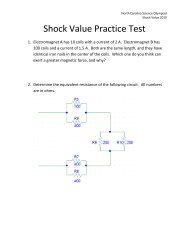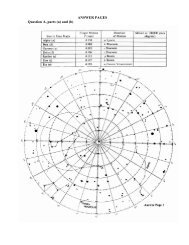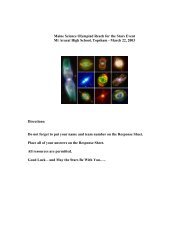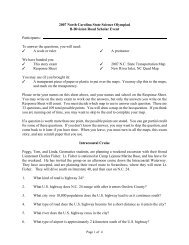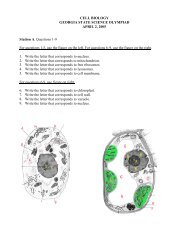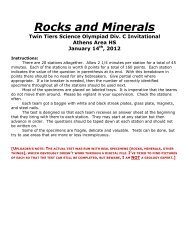National Science Olympiad - Science Olympiad Student Center
National Science Olympiad - Science Olympiad Student Center
National Science Olympiad - Science Olympiad Student Center
Create successful ePaper yourself
Turn your PDF publications into a flip-book with our unique Google optimized e-Paper software.
<strong>National</strong> <strong>Science</strong> <strong>Olympiad</strong><br />
Astronomy C Division Event<br />
31 May 2008<br />
George Washington University<br />
Washington, DC<br />
TEAM NUMBER: ________________<br />
TEAM NAME: ___________________________________________<br />
INSTRUCTIONS:<br />
1) Please turn in ALL MATERIALS at the end of this event.<br />
2) Do not forget to put your TEAM NAME and TEAM NUMBER at<br />
the top of all Answer Pages.<br />
3) This event and the answer key will be available on the Wright <strong>Center</strong> website:<br />
http://www.tufts.edu/as/wright_center/products/sci_olympiad/sci_olympiad_astro.html<br />
4) Good Luck! And May the Stars be With You!<br />
Page 1
Team Number: ____________ Team Name: ________________________________<br />
Section A: Use the 5-page Image Set to answer the questions in this section.<br />
1) Image G went through three specific types of variability during its<br />
evolutionary history.<br />
a) Name the three types of variability in the order that they occurred.<br />
b) What two images contain light curves that represent the first and final<br />
stages of variability?<br />
c) Where on the HR diagram are the first two stages of variability<br />
located in the order that they occurred?<br />
2) UV Ceti is a type of variable star that randomly varies in light intensity in<br />
localized areas.<br />
a) Which image contains a light curve produced by UV Ceti?<br />
b) What type of variable star is UV Ceti?<br />
c) Where is UV Ceti located on the HR diagram?<br />
3) Image I contains a unique light curve with two types of outbursts.<br />
a) Which Deep Sky Objects produces this type of variability?<br />
b) The systems that produce these types of outbursts are comprised of<br />
what components?<br />
c) What two images contain the type of object that would result of the<br />
primary component acquired too much mass?<br />
d) Which image contains an example of this type of system?<br />
4) AH Leo is a type of variable star that can be used to measure distances to<br />
globular clusters.<br />
a) Which image contains the light curve produced by AH Leo?<br />
b) Where on the HR diagram is this type of variable star located?<br />
c) What type of variable star is AH Leo?<br />
d) What area on the HR diagram did AH Leo occupy prior to its current<br />
position?<br />
5) Image M illustrates a type of variability that results from the accumulation<br />
of carbon in the outer atmosphere of a star.<br />
a) Which Deep Sky Object does Image M represent?<br />
b) Which image contains a representative light curve for this object?<br />
c) What type of variable star is this object?<br />
d) The period of this object is getting shorter. Which diagram shows this<br />
behavior?<br />
6) W Virginis is a Type II Cepheid variable star.<br />
a) Which image shows the classic behavior of this type of variable?<br />
b) What is the difference between a Type II light curve and a Type I?<br />
c) Would you expect the color of a Cepheid variable star to change<br />
during the star’s oscillation period? If not, why not? If so, describe<br />
why the color should change, and the color changes you would expect<br />
to see during an oscillation period.<br />
Page 2
Team Number: ____________ Team Name: ________________________________<br />
7) GRO J1655-40 is an X-ray binary system comprised of a black hole and a<br />
main sequence star.<br />
a) Which image shows this system?<br />
b) Image C shows the spectrum of GRO J1655-40. The yellow lines show<br />
a model spectrum, and the blue lines show the observed spectrum. In<br />
the model spectrum the absorption dips are plotted at their natural<br />
wavelengths. Describe the difference between the observed and model<br />
spectra and the motion of the wind from this object relative to Earth.<br />
8) Compare the two light curves in Images A and L.<br />
a) What is the period of the light curve in Image A?<br />
b) What is the period of the light curve in Image L?<br />
c) These two light curves represent what general type of variability?<br />
d) Which one is produced by the mira R Cygni?<br />
e) Which one is produced by the red giant V725?<br />
f) Which object is the younger of the two, R Cygni or V725?<br />
g) More massive main-sequence stars turn into red giants before less<br />
massive main sequence stars. How then is it possible in a binary<br />
system to have the more massive star the main sequence star, and the<br />
less massive star a red giant?<br />
9) The massive supernova SN 2006 gy is illustrated in Image O.<br />
a) What other image contains this object?<br />
b) What is the dimmer object in the image containing SN 2006 gy??<br />
c) What type of stellar core remains at the center of this supernova<br />
remnant?<br />
10) Image K is an illustration of RX J0806.3+1527 - a binary system with an<br />
orbital period that is slowing decreasing by 1.2 ms/year.<br />
a) Which image shows the light curve for this object?<br />
b) Are the two objects slowing down or speeding up?<br />
c) The objects are 50,000 miles apart and moving closer by 2 feet per<br />
year. How many years will it take for them to coalesce?<br />
d) Where are these objects located on the HR diagram?<br />
11) Describe the behavior of the variable star in the diagram in Image N.<br />
12) Draw curves on the O-C diagrams to represent the follow variable star<br />
Behaviors.<br />
a) The period lengthens and then shortens but remains periodic<br />
b) The period is periodic and unchanged, but maxima (epoch) changes<br />
c) Correct period, periodic, wrong maxima (epoch)<br />
Page 3
Team Number: ____________ Team Name: ________________________________<br />
13) Star A and Star B are members of an orbital binary star system that is<br />
observed to have a separation of 3.0 A.U. and a period of 1.0 years. What is<br />
the combined mass of system (in Solar Masses)?<br />
14) The luminosity of Star A is observed to be 8.0 times the luminosity of Star B.<br />
If the luminosity-mass relationship for both stars is described by the<br />
equation below, what is the distance from Star A to the center of mass of the<br />
system (in A.U.)?<br />
3<br />
L<br />
L Sun<br />
= M ⎛<br />
⎜<br />
⎝<br />
M Sun<br />
15) Star C and Star D have equal masses, luminosities, and spectral classes.<br />
They are also members of a spectroscopic binary star system that is observed<br />
to have a separation of 6.0 x 10 7 km and a period of 10.0 days. What is the<br />
orbital velocity of Star C (in km/s)?<br />
16) In the spectrum for Star C, the Hα was measured to have a wavelength of<br />
656.5386 nm compared with a laboratory value of 656.3000 nm. What is the<br />
angle between the plane of the systems orbit and the line of sight of the<br />
observer (in degrees)?<br />
17) Which of the following most closely resembles the light curve produced by<br />
the system of Star C and Star D.<br />
(a) (b) (c)<br />
18) Star E is an RR Lyrae variable with surface temperature of 8,500 K. In<br />
which wavelength range would an image of the star be brightest?<br />
a) Radio b) Microwave c) I.R. d) Visible e) U.V. f) X-ray g) Gamma ray<br />
Page 4<br />
⎞<br />
⎟<br />
⎠<br />
θ
Team Number: ____________ Team Name: ________________________________<br />
19) Star F is measured to be the same distance away and have 1/2 the angular<br />
diameter of Star E. It also is measure to radiate the maximum amount of<br />
energy at a wavelength 1/2 that at which Star E does so. How many times<br />
more energy doe Star F radiate on the earth’s surface in a year than Star E?<br />
20) Star G produced the light curve below. What is its period (in days)?<br />
0 2.69 5.37 8.06 10.75 Days<br />
21) If the light curve for Star G above was used as an observation, what was the<br />
calculated period (in days) used to produce the O-C diagram below?<br />
(days)<br />
50<br />
25<br />
0<br />
O-C<br />
0 50 100 (days)<br />
Page 5
Team Number: ____________ Team Name: ________________________________<br />
22) Using the chart below and a value of +4.83 for the absolute magnitude of the<br />
Sun, calculate the distance to Star G (in parsecs)<br />
23) Star H has a measured parallax of 0.0148 arc seconds and produced the light<br />
curve below. What is the distance from Star H to the Sun (in parsecs)?<br />
24) Which of the following spectra is closest to that of Star H?<br />
a)<br />
b)<br />
c)<br />
Page 6
Team Number: ____________ Team Name: ________________________________<br />
25) Cluster I is a globular cluster with a parallax of 0.00025 arc seconds and an<br />
angular diameter of 25.8 arc minutes. What is the physical diameter of<br />
Cluster I (in parsecs)?<br />
26) Cluster II has a parallax of 0.000125 arc seconds and an angular diameter of<br />
25.8 arc minutes. Cluster II also has the same total mass as Cluster I.<br />
Approximately how many times smaller is the angular velocity of a star at the<br />
outer edge of Cluster II than one at the outer edge of Cluster I?<br />
27) If an X-ray detector measures 1 mW of power from an X-ray binary 2.5 kpc<br />
away, how much energy (in mW) would it measure from an equally bright xray<br />
binary 5 kpc away?<br />
28) Star I and Star J are part of an X-ray binary system with a period of 5.6 days<br />
and a separation of 0.095 A.U. Star I has a mass of 1.0 solar mass. What type<br />
of star is Star J?<br />
Page 7




